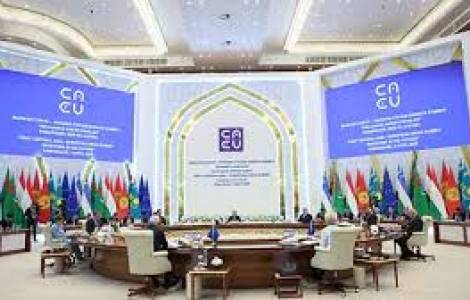
consilium.europa.eu
by Cosimo Graziani
Samarkand (Agenzia Fides) - The recent meeting between the leaders of the European Union and those of the Central Asian countries, held in Samarkand on April 4, likely marks a new beginning in relations between the two regions: it is, in fact, the first meeting with the European Union following the "5+1" format, which has been used in the past for meetings between Central Asian countries and individual nations such as Germany, France, China, Japan, and Russia.
During the summit, numerous topics of common interest were discussed: from the situation in Afghanistan to terrorism, connectivity, economic relations, human rights, and the strategic resources of which the region is particularly rich. Relations between the EU and the five countries of the former Soviet Union were considered a strategic partnership, a sign that Brussels wishes to establish stable and solid long-term ties. On the other hand, significant investments are expected in the region in the Global Gateway, the European infrastructure plan conceived as an alternative to China's Belt and Road Initiative (BRI), as well as in the area of critical materials and rare earth extraction.
The fact that the EU follows the "5+1" format is a sign of Brussels' attempt to bring relations with all States to the same level in order to be a strong player compared to other international competitors. A bilateral Enhanced Partnership and Cooperation Agreement (EPCA) is already in force with Kazakhstan and Kyrgyzstan, which governs legal and economic relations, while the same agreement is not yet in force with Tajikistan and Uzbekistan, and its signing with Turkmenistan is not currently planned. These differences place European institutions at a disadvantage in their approach to the region compared to actors such as China and Russia, which also have long-standing historical, geographical, and demographic factors on their side to influence the region.
The ongoing process does not appear to be a simple new version of the 19th-century "Big Game" played out in Central Asia by individual powers such as Russia and England, according to those who tend to minimize international politics and geopolitics in Central Asia. However, this approach emphasizes the actions of external powers in the region and implies a lack of strategy on the part of local States. If this view was already reductive in the 1990s, when national interests were beginning to emerge, it is even more so today, when those interests are clearly defined. Foreign powers seeking to establish relations with the region must assume that local governments are now less willing to make concessions and more prepared to firmly defend their own interests.
The April 4 summit reaffirmed an important phenomenon in Central Asian politics: regionalization. The application of the "5+1" format indicates that the countries of the region are beginning to coordinate with each other to act jointly in the field of foreign relations, consolidating common interests. Is it possible that a regional organization similar to ASEAN or even the European Union could emerge in the future? It is difficult to foresee. Such a scenario would entail the creation of a common market and the sharing of resources such as oil, gas, and rare earths, which constitute—in most of these countries—the main source of national income, under strict state control. It would also entail a convergence of economic development models, which currently differ considerably: from openness to foreign investment in Uzbekistan to the heavily gas-dependent economy in Turkmenistan.
The most important fact is certainly that some political issues are already perceived as being of common interest, so there is a possible path forward that can be followed together. (Agenzia Fides, 21/5/2025)